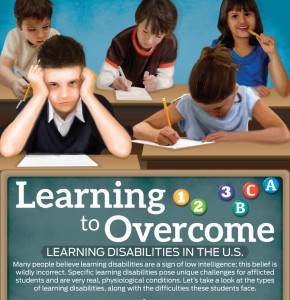Reviewed by Mary McLaughlin, Special Education Teacher; M.S. SpEd
Learning Disabilities in the U.S.
Many people believe learning disabilities are a sign of low intelligence; this belief is wildly incorrect. Specific learning disabilities pose unique challenges for afflicted students and are very real, physiological conditions. Let’s take a look at the types of learning disabilities, along with the difficulties these students face.
What is a Learning Disability?
Learning disabilities are disorders that affect an individual’s basic psychological processes involved in comprehending specific information. This includes conditions such as perceptual handicaps, brain trauma, developmental aphasia and brain dysfunction that manifest as language and reasoning problems.
What a learning disability is NOT:
Visual, hearing or motor handicaps, or emotional disturbance
4% to 6%
Percentage of American students with a learning disability
4.6 million
People in the U.S. with learning disabilities
1 in 2
Public school students in special education who have learning disabilities
80%
Percentage of learning disabilities in teens that are associated with reading
The Most Prominent Learning Disabilities
Five learning disabilities are the most prominent among school-age children. Let’s take a look at those five: their symptoms, possible causes and common issues.
Dyscalculia
What: General mathematical disability in which person cannot comprehend quantity, positive and negative number values, fractions and many simple mathematical operations
Signs: Issues with word problems, handling money, figuring out days/months, long division and patterns.
Dysgraphia
What: Writing difficulties; usually linked to brain trauma
Signs: Writing in a distorted way, consistently incorrectly spelling words and oddly spacing letters
Dyspraxia
What: Motor skills problems
Signs: Poor sense of balance and hand-eye coordination; clumsiness, frequently stumbling; irritation from loud noises and touch
In the brain: Two hemispheres in the cerebral cortex do not share information or respond to each other properly as in an unaffected brain
Dyslexia
What: Reading disorder; recently linked to genetics
Signs: Reading at lower levels than expected; inability to phonologically process words
In the brain: Most likely angular gyrus, an area toward the back of the brain that understands and translates language
ADHD
What: Inability to focus; most common learning disability
Signs: Increased, random hyperactivity, impulsivity, short attention spans and disruptive behavior
In the brain: Neurological, but doctors have yet to uncover the specific root of the issue inside the brain
Gerstmann’s Syndrome
What: Often seen after stroke or brain injury, this disorder can manifest itself via several different learning disabilities, including dysgraphia and dyscalculia
Signs: Inability to differentiate between right and left; difficulty expressing thoughts in speech and writing
In the brain: Left parietal lobe of the brain is damaged, in the angular gyrus region
The Signs
At different ages there are specific ways to tell if a child has a learning disability. Let’s take a look at each age group where learning disabilities are commonly diagnosed and what some common signs and symptoms are.
Preschool
- Pronunciation difficulty
- Has a hard time memorizing the alphabet
- Trouble using buttons and zippers or tying shoes
- Cannot properly control pencils or crayons
Ages 5-9
- Hard time connecting letters and sounds
- Frequent misspellings and misreading
- Is slow learning new skills
- Cannot blend multiple sounds to form new words
Ages 10-13
- Reading comprehension issues
- Avoids reading out loud
- Spelling the same word differently throughout a document
- Bad organizational skills
Overcoming Obstacles
People with learning disabilities come upon specific challenges when looking toward their futures. For many, the odds of graduating college and finding an applicable career are against them. Let’s take a look at some statistics that illustrate the difficulties people with learning disabilities must face regarding education and economic status.
Those with learning disabilities General population
Graduate from high school 67% 74%
Employed 55% 76%
Enroll in four-year college 10% 28%
Apply to graduate schools after college 29.3% 40%
Live at or below poverty line 43% 15.1%
Receive outside tutoring 16% 5%
Diagnosed with psychological difficulties 14.7% 1%
SOURCES:
http://www.floridatechnet.org
http://www.ldao.ca
http://www.npc.umich.edu
http://www.ncld.org
http://www.floridatechnet.org
http://www.helpguide.org
http://www.neuroanatomy.wisc.edu
http://bbrfoundation.org
http://www.dyspraxiafoundation.org.uk
http://www.teenhelp.com
http://www.ldhope.com
http://www.nimh.nih.gov
http://www.ldaamerica.org
http://www.thearc.org








